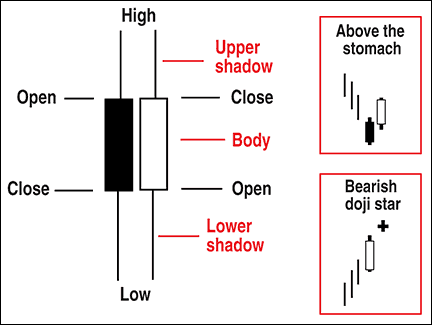Original article:
Investment Candles
// Stocks & commodities, http://traderscom.stores.yahoo.net/stcov292inca.html
// V. 29:5 (24-28):
Which candlesticks work best as reversal or continuation patterns? Find out here.
Investment-grade candlesticks work as reversal or continuation patterns at least two-thirds of the time (66%), and they are plentiful. By “plentiful,” I mean that I sorted a list of 103 candlestick patterns by how often they appeared in the Standard & Poor’s 500 from August 1996 to August 2006. I split the list and discarded the rare ones. That left just 13 candle types, which I describe here.Configuration and definition
Before I discuss the performers, let’s review the configuration. Figure 1 shows two candlesticks, one black and the other white. The price bar’s high is at the top of the candle, and the low is at the bottom. Between those two extremes are the opening and closing prices, the order of which determines the candle body’s shade. The thin bars at either end are the shadows or wicks, with a body sandwiched in between. A candle need not have a shadow, and the body can be a flat line as in a four-price doji. In those situations, all four prices are the same.

Figure 1: basic candlestick configuration, above the stomach and bearish doji. Here you see the configuration of a candlestick, a reversal pattern that appears in a short-term downtrend referred to as “above the stomach” and a bearish doji star, which is considered to be a bearish reversal but doesn’t act that way 69% of the time.
***
The developing of 3 indicators is necessary for intepreting automatically such configurations:
a) doji exists (see blog) - "bearish doji star" is just a particular case
b) indicator where open and close are in the opposite direction and a percentage of previous bar in included in the present one
c) the above-the-stomach configuration of the last bar
"Above the Stomach
Bullish reversal pattern with market in a down trend. Next session opens above middle of prior black real body and closes at or above that level"
SEE THIS GOOGLE DOCUMENT OFR THE FORMULA (FREE ENTRY)
PRO REAL TIME FORMULA INVESTMENT CANDLESSEE THIS GOOGLE DOCUMENT OFR THE FORMULA (FREE ENTRY)
===================================
In november 2011's issue of Stock & Commodities, the power of predicability of such candles is discussed: 10 candles!! wonderful!!
The Eight Best-Performing Candles
The Simpler They Are?
After removing rare candlesticks and combining reversal or continuation rates with performance after 10 days, surprising winners emerge.
Those of you well versed in candlesticks will find this article surprising. It describes how single-line candles can lead to the best performance. In an earlier article, I discussed investment-grade candles, those that performed best as reversal or continuation patterns. In another article, I discussed candles that led to strong moves 10 days later.This article combines those two qualities and adds a third filter that removes rare candles to uncover the eight best-performing candles overall.
Definitions and methodology
Describing my testing methodology is necessary so everyone understands my measurement technique. I looked at more than 4.7 million price bars (candle lines) to identify and track 103 candle patterns. A close above the top of a candle represents an upward breakout. Similarly, a close below the bottom of the candle pattern is a downward breakout. That’s true of most candle patterns except for unusually tall ones, such as eight or 13 new price lines, where I used the last price bar upon which to conduct the up or down breakout test.
Describing my testing methodology is necessary so everyone understands my measurement technique. I looked at more than 4.7 million price bars (candle lines) to identify and track 103 candle patterns. A close above the top of a candle represents an upward breakout. Similarly, a close below the bottom of the candle pattern is a downward breakout. That’s true of most candle patterns except for unusually tall ones, such as eight or 13 new price lines, where I used the last price bar upon which to conduct the up or down breakout test.
If price entered the candlestick from the bottom but exited out the top, it acted as a continuation. Similarly, if it exited in the same direction that it entered (entering from above and exiting upward, for example), the candle acted as a reversal.
To exclude rare candles, I ranked the frequency of each candle found in the same database (500 stocks of 10 years’ duration). I split the frequency rank in half and threw out the rare ones (the rare half).
To find which candles had the best overall performance, I started with the plentiful candles, measured and ranked the reversal or continuation rates, added a rank for the price move after 10 days, and ranked the result. The idea was to find candles that performed best as reversal or continuation patterns, trended far enough in the breakout direction to make money, and appeared often enough to be identified. Here, I describe the top two candles in each category.
FIGURE 1: BULLISH REVERSALS. Here you see the top two-performing candlestick patterns that act as bullish reversals.

No comments:
Post a Comment